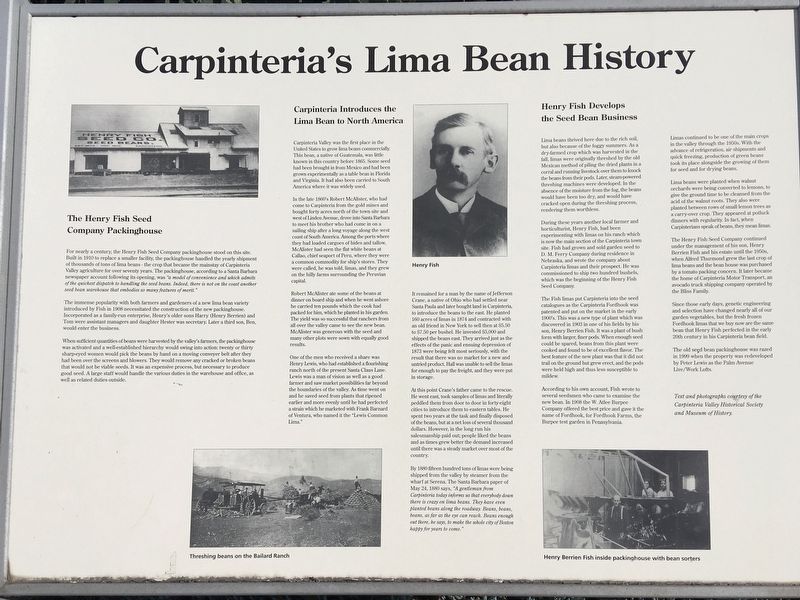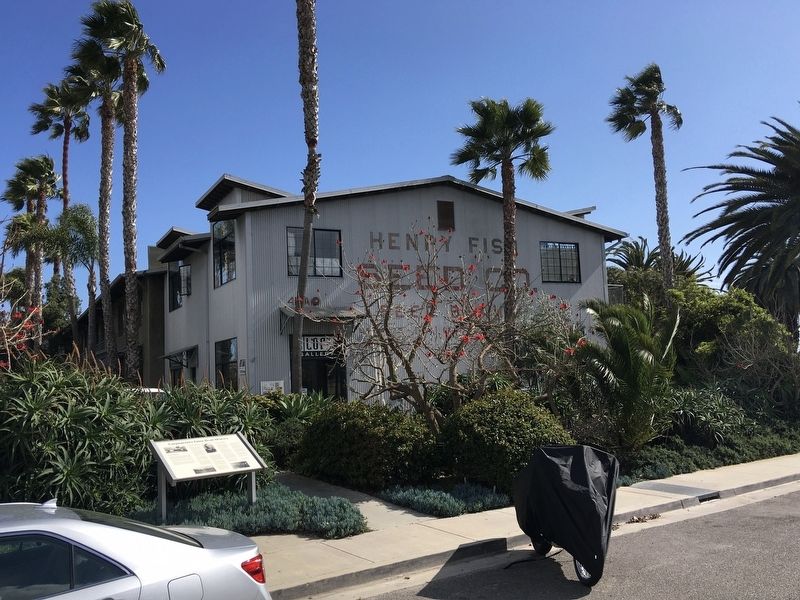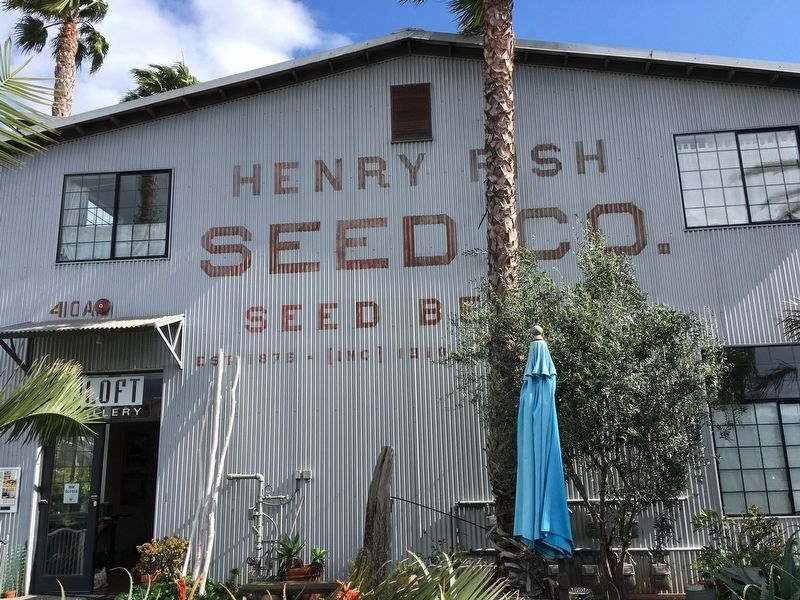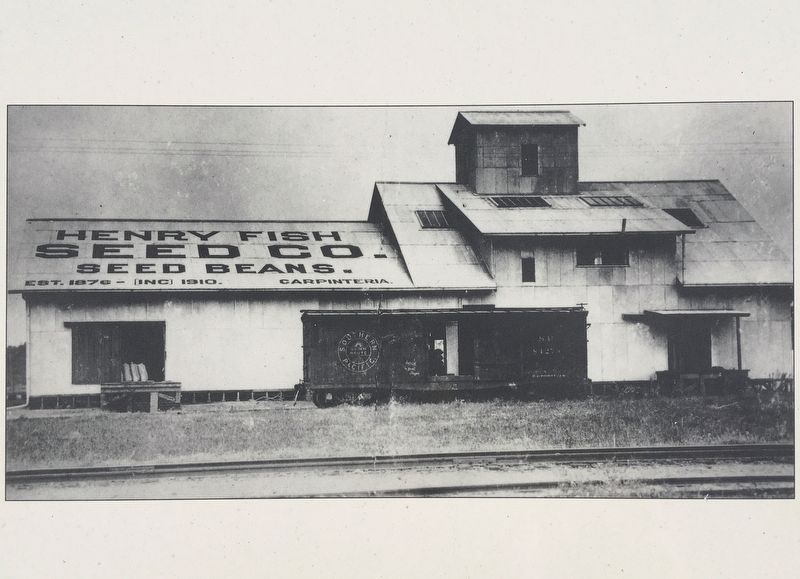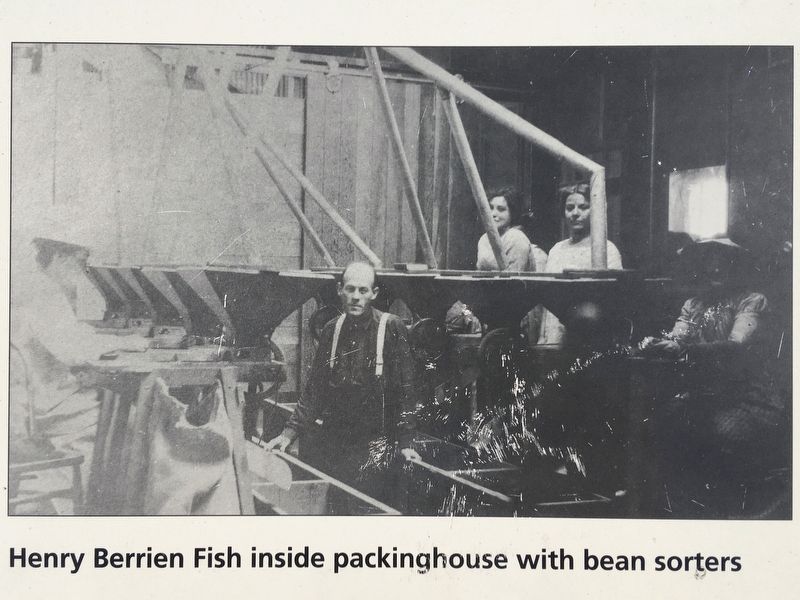Carpinteria in Santa Barbara County, California — The American West (Pacific Coastal)
Carpinteria’s Lima Bean History
The Henry Fish Seed Company Packinghouse
For nearly a century, the Henry Fish Seed Company packinghouse stood on this site. Built in 1910 to replace a smaller facility, the packinghouse handled the yearly shipment of thousands of tons of lima beans - the crop that became the mainstay of Carpinteria Valley agriculture for over seventy years. The packinghouse, according to a Santa Barbara newspaper account following its opening, was "a model of convenience and which admits of the quickest dispatch to handling the seed beans. Indeed, there is not on the coast another seed bean warehouse that embodies so many features of merit."
The immense popularity with both farmers and gardeners of a new lima bean variety introduced by Fish in 1908 necessitated the construction of the new packinghouse. Incorporated as a family-run enterprise, Henry's older sons Harry (Henry Berrien) and Tom were assistant managers and daughter Hester was secretary. Later a third son, Ben, would enter the business.
When sufficient quantities of beans were harvested by the valley's farmers, the packinghouse was activated and a well-established hierarchy would swing into action: twenty or thirty sharp-eyed women would pick the beans by hand on a moving conveyer belt after they had been over the screens and blowers. They would remove any cracked or broken beans that would not be viable seeds. It was an expensive process, but necessary to produce good seed. A large staff would handle the various duties in the warehouse and office, as well as related duties outside.
Carpinteria Introduces the Lima Bean to North America
Carpinteria Valley was the first place in the United States to grow lima beans commercially. This bean, a native of Guatemala, was little known in this country before 1865. Some seed had been brought in from Mexico and had been grown experimentally as a table bean in Florida and Virginia. It had also been carried to South America where it was widely used.
In the late 1860's Robert McAlister, who had come to Carpinteria from the gold mines and bought forty acres north of the town site and west of Linden Avenue, drove into Santa Barbara to meet his brother who had come in on a sailing ship after a long voyage along the west coast of South America. Among the ports where they had loaded cargoes of hides and tallow, McAlister had seen the flat white beans at Callao, chief seaport of Peru, where they were a common commodity for ship's stores. They were called, he was told, limas, and they grew on the hilly farms surrounding the Peruvian capital.
Robert McAlister ate some of the beans at dinner on board ship and when he went ashore he carried ten pounds which the cook had packed for him, which he planted in his garden. The yield was so successful that ranchers from all over the valley came to see the new bean. McAlister was generous with the seed and many other plots were sown with equally good results.
One of the men who received a share was Henry Lewis, who had established a flourishing ranch north of the present Santa Claus Lane. Lewis was a man of vision as well as a good farmer and saw market possibilities far beyond the boundaries of the valley. As time went on and he saved seed from plants that ripened earlier and more evenly until he had perfected a strain which he marketed with Frank Barnard of Ventura, who named it the "Lewis Common Lima."
It remained for a man by the name of Jefferson Crane, a native of Ohio who had settled near Santa Paula and later bought land in Carpinteria, to introduce the beans to the east. He planted 160 acres of limas in 1874 and contracted with an old friend in New York to sell then at $5.50 to $7.50 per bushel. He invested $5,000 and shipped the beans east. They arrived just as the effects of the panic and ensuing depression of 1873 were being felt most seriously, with the result that there was no market for a new and untried product. Hall was unable to sell the limas for enough to pay the freight, and they were put in storage.
At this point Crane's father came to the rescue. He went east, took samples of limas and literally peddled them from door to door in forty-eight cities to introduce them to eastern tables. He spent two years at the task and finally disposed of the beans, but at a net loss of several thousand dollars. However, in the long run his salesmanship paid out; people liked the beans and as times grew better the demand increased until there was a steady market over most of the country.
By 1880 fifteen hundred tons of limas were being shipped from the valley by steamer from the wharf at Serena. The Santa Barbara paper of May 24, 1880 says, "A gentleman from Carpinteria today informs us that everybody down there is crazy on lima beans. They have even planted beans along the roadway. Beans, beans, beans, as far as the eye can reach. Beans enough out there, he says, to make the whole city of Boston happy for years to come."
Henry Fish Develops the Seed Bean Business
Lima beans thrived here due to the rich soil, but also because of the foggy summers. As a dry-farmed crop which was harvested in the fall, limas were originally threshed by the old Mexican method of piling the dried plants in a corral and running livestock over them to knock the beans from their pods. Later, steam-powered threshing machines were developed. In the absence of the moisture from the fog, the beans would have been too dry, and would have cracked open during the threshing process, rendering them worthless.
During these years another local farmer and horticulturist, Henry Fish, had been experimenting with limas on his ranch which is now the main section of the Carpinteria town site. Fish had grown and sold garden seed to D. M. Ferry Company during residence in Nebraska, and wrote the company about Carpinteria limas and their prospect. He was commissioned to ship two hundred bushels, which was the beginning of the Henry Fish Seed Company.
The Fish limas put Carpinteria into the seed catalogues as the Carpinteria Fordhook was patented and put on the market in the early 1900's. This was a new type of plant which was discovered in 1903 in one of his fields by his son, Henry Berrien Fish. It was a plant of bush form with larger, finer pods. When enough seed could be spared, beans from this plant were cooked and found to be of excellent flavor. The best feature of the new plant was that it did not trail on the ground but grew erect, and the pods were held high and thus less susceptible to mildew.
According to his own account, Fish wrote to several seedsmen who came to examine the new bean. In 1908 the W. Atlee Burpee Company offered the best price and gave it the name of Fordhook, for Fordhook Farms, the Burpee test garden in Pennsylvania.
Limas continued to be one of the main crops in the valley through the 1950s. With the advance of refrigeration, air shipments and quick freezing, production of green beans took its place alongside the growing of them for seed and for drying beans.
Lima beans were planted when walnut orchards were being converted to lemons, to give the ground time to be cleansed from the acid of the walnut roots. They also were planted between rows of small lemon trees as a carry-over crop. They appeared at potluck dinners with regularity. In fact, when Carpinterians speak of beans, they mean limas.
The Henry Fish Seed Company continued under the management of his son, Henry Berrien Fish and his estate until the 1950s, when Alfred Thurmond grew the last crop of lima beans and the bean house was purchased by a tomato packing concern. It later became the home of Carpinteria Motor Transport, an avocado truck shipping company operated by the Bliss Family.
Since those early days, genetic engineering and selection have changed nearly all of our garden vegetables, but the fresh frozen Fordhook limas that we buy now are the same bean that Henry Fish perfected in the early 20th century in his Carpinteria bean field.
The old seed bean packinghouse was razed in 1999 when the property was redeveloped by Peter Lewis as the Palm Avenue Live/Work Lofts.
Text and photographs courtesy of the Carpinteria Valley Historical Society and Museum of History.
Topics. This historical marker is listed in these topic lists: Agriculture • Industry & Commerce.
Location. 34° 23.59′ N, 119° 31.185′ W. Marker is in Carpinteria, California, in Santa Barbara County. Marker is on Palm Avenue, 0.1 miles south of 6th Street, on the left when traveling south. Touch for map. Marker is at or near this postal address: 410 Palm Ave, Carpinteria CA 93013, United States of America. Touch for directions.
Other nearby markers. At least 8 other markers are within walking distance of this marker. Portolá Sycamore (about 800 feet away, measured in a direct line); La Carpinteria (approx. 0.3 miles away); a different marker also named La Carpinteria (approx. 0.3 miles away); La Viña Grande (approx. 0.3 miles away); “World’s Safest Beach” (approx. 0.3 miles away); Wardholme Torrey Pine (approx. 0.4 miles away); a different marker also named La Carpinteria (approx. half a mile away); Carpinteria Aviation History (approx. 0.7 miles away). Touch for a list and map of all markers in Carpinteria.
Credits. This page was last revised on July 8, 2020. It was originally submitted on July 8, 2020, by Craig Baker of Sylmar, California. This page has been viewed 1,286 times since then and 628 times this year. Photos: 1, 2, 3, 4, 5. submitted on July 8, 2020, by Craig Baker of Sylmar, California. • J. Makali Bruton was the editor who published this page.
